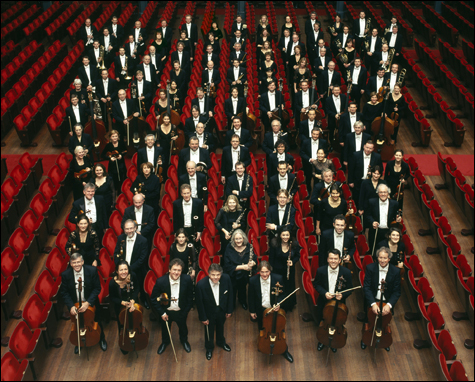
THE ROYAL CONCERTGEBOUW ORCHESTRA OF AMSTERDAM: Only the Berlin and the Vienna
Philharmonics play like this. |
The first LP I ever bought, way back in 1963, offered Chopin’s E-minor piano concerto performed by obscure artists — Bella Davidovich with Arvids Jansons leading the USSR State Symphony Orchestra — on the equally obscure Soviet Mezhdunarodnaya Kniga label. The release has never been transferred to CD, and even the LP languishes in obscurity, unknown to Google or eBay; yet it’s as fine a performance as any I know, unsurpassed by the likes of Pollini and Argerich, and a major reason is the steady, tender hand of Latvian conductor Jansons, who treats Chopin’s oft-denigrated orchestration with affection and respect.
Like father, like son? Not exactly — Mariss Jansons, who came to Symphony Hall Friday with the Royal Concertgebouw Orchestra of Amsterdam, is more given to passionate tempo fluctuations than his dad was (at least to judge by that one recording). But he has the same grasp of structure and dance pulse and instrumental balance, and the same gift for turning notes into music. This Boston visit by the Concertgebouw, its first since 1999, was sponsored by the Celebrity Series, which touted the orchestra as “one of the world’s leading symphonic ensembles” — an understatement, on the evidence of what we heard Friday. Only the Berlin and the Vienna Philharmonics play like this, and for the Berliners’ Symphony Hall visit last November, the Celebrity Series was obliged to charge a top price of $187; top price for the Concertgebouw was $80. And the BSO? “American orchestras are very disciplined, technically perfect, rhythmical,” Jansons told the New York Times’ Alan Riding in 2005. “Europeans give more attention to style and phrasing and sound.” That’s about the size of it, except that this Concertgebouw lacked nothing in discipline or technique or rhythm.

The program seemed ill-chosen, French music — Debussy’s La mer and Berlioz’s Symphonie fantastique — for a city whose own orchestra is steeped in the French tradition. Wouldn’t Mahler’s Fifth Symphony, which had drawn raves in San Francisco and Los Angeles, have been a more appropriate choice? As it turned out, no: this Symphonie fantastique, at least, outshone the ones Seiji Ozawa and James Levine have conducted with the BSO.
La mer requires a precisely delineated color palette if it’s to avoid sounding like ocean background music. Even with the violins grouped on his left (as opposed to the antiphonal deployment that Levine has adopted with the BSO), Jansons, using a baton and conducting from the score, achieved an exemplary clarity. The musical waters glinted and sparkled with sunlight. There was a nasal edge to the winds, a metallic sheen to the brass, and plenty of room for the two harps; the cellos cavorted like sleek poodles. It was aural Champagne, crisp and with many flavors.
You can tell from the opening two bars of the Symphonie fantastique whether it’s the real thing: those detached oboe triplets have to drag a little — a ritard not marked in the score — as they move up to E-flat, to suggest Berlioz’s opium-dream languor. This was the real thing. Jansons was very delicate with the slow (and for once it was slow) introduction, marking his paragraphs with pointed pauses. When he did let loose, the orchestra maintained its transparency, Jansons crossing the bar lines to convey the kinetic asymmetry of Berlioz’s phrasing. He didn’t take the exposition repeat; for this dramatic reading, no repeat was needed. The first movement climaxed in a delirious ejaculation, with pounding timpani, and then the “religiosamente” coda, as reverent as Romeo and Juliet contemplating Friar Laurence’s cell after their night of love.
The “Un bal” second movement, its onset delayed by an inexcusable degree of coughing from the audience, danced lightly, preserving in the cellos and basses its pulse points even when Jansons sped up. The clarinet solo that marks the entrance of the Beloved had an easy elegance — you could practically see the light from the chandeliers glittering off her tiara. Compensating for the absence of Berlioz’s optional cornets, which give texture and a military air to the proceedings, was the Viennese lilt — those little luftpausen — with which the movement waltzed.
The cor anglais and oboe duet that opens the “Scène aux champs” was briefly compromised by an ambulance siren outside, but the soloists were undeterred, and the rustic purity of the strings thereafter conjured thoughts of Vergil’s First Eclogue, a contented Tityrus watching the smoke curl up from his farmhouse chimney. The two big climaxes unfolded naturally, without hysteria, though one might have asked for a greater sense of foreboding, and the thunder at the end seemed very close. Ruth Visser’s sinuous cor anglais was a joy throughout. The “Marche au supplice” strutted and swaggered, as if the tumbrel carrying our hero to the guillotine were rocking from side to side — no haste here, either, just a glorious solarity from the brass that made me wish Jansons had taken this repeat. And the Witches’ Sabbath finale was the scarier for not going helter-skelter, Jansons weighting the laughter and letting the round dance go in tempo, an actual dance. The Beloved, now represented by the calliope-like E-flat clarinet, usually comes off as a whore; here she was a courtesan. It all built to another blinding brass burst of light.
Only one encore, “Solveig’s Song,” from the incidental music Grieg wrote for Peer Gynt, the strings noble and refined, the dance pulse gently swaying. The audience was ready for more (in San Francisco the orchestra also encored the Rakoczy March from Berlioz’s Damnation de Faust), but more was not forthcoming. They had nothing left to prove.